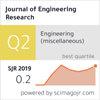窗户朝向、玻璃和窗墙比对办公楼冷暖能量的影响:以炎热半干旱气候为例
IF 0.9
4区 工程技术
Q3 ENGINEERING, MULTIDISCIPLINARY
引用次数: 0
摘要
在整个设计阶段采用合适的设计策略,可提高建筑物的节能潜力。在这项研究中,正在伊拉克基尔库克市调查影响窗户设计的因素,如窗墙比(WWR)和窗户朝向,以及不同的玻璃材料,以减少可能的能源消耗。本研究对该地区的典型办公楼进行了仿真分析;评估了四种WWRs,四种朝向和三种窗户玻璃材料,例如透明,灰色和理论,以及单层和双层玻璃窗。结果表明,当水比为100%时,南向窗户采用双层透明玻璃可以达到最低的采暖消耗。对于朝北的窗户,最小的冷却消耗是采用双理论-197玻璃,25%的水冷比。建筑师和施工经理可以利用这些措施以一种易于理解的方式与客户沟通信息,从而做出更好的窗口设计决策。本文章由计算机程序翻译,如有差异,请以英文原文为准。
The impact of window orientation, glazing, and window-to-wall ratio on the heating and cooling energy of an office building: The case of hot and semi-arid climate
Adopting suitable design strategies in buildings throughout the design stage provides increased energy-saving potential. In this study, factors influencing window design, such as the window-to-wall ratio (WWR) and window orientation, along with different glazing materials, are being investigated in the city of Kirkuk, Iraq for possible energy consumption reduction. The study presents a simulation-based analysis on a typical office building in the area; evaluating four WWRs, four orientations, and three window glazing materials, e.g., clear, gray, and theoretical, as well as single and double-glazed windows. The results indicate that minimum heating consumption could be achieved with double clear glass for south-facing windows if WWR was 100 %. For north-facing windows, minimum cooling consumption is achieved with double theoretical-197 glass with a 25 % WWR. These measures can be utilized by architects and construction managers to communicate information to customers in an understandable manner and make better window design decisions.
求助全文
通过发布文献求助,成功后即可免费获取论文全文。
去求助
来源期刊

Journal of Engineering Research
ENGINEERING, MULTIDISCIPLINARY-
CiteScore
1.60
自引率
10.00%
发文量
181
审稿时长
20 weeks
期刊介绍:
Journal of Engineering Research (JER) is a international, peer reviewed journal which publishes full length original research papers, reviews, case studies related to all areas of Engineering such as: Civil, Mechanical, Industrial, Electrical, Computer, Chemical, Petroleum, Aerospace, Architectural, Biomedical, Coastal, Environmental, Marine & Ocean, Metallurgical & Materials, software, Surveying, Systems and Manufacturing Engineering. In particular, JER focuses on innovative approaches and methods that contribute to solving the environmental and manufacturing problems, which exist primarily in the Arabian Gulf region and the Middle East countries. Kuwait University used to publish the Journal "Kuwait Journal of Science and Engineering" (ISSN: 1024-8684), which included Science and Engineering articles since 1974. In 2011 the decision was taken to split KJSE into two independent Journals - "Journal of Engineering Research "(JER) and "Kuwait Journal of Science" (KJS).
 求助内容:
求助内容: 应助结果提醒方式:
应助结果提醒方式:


